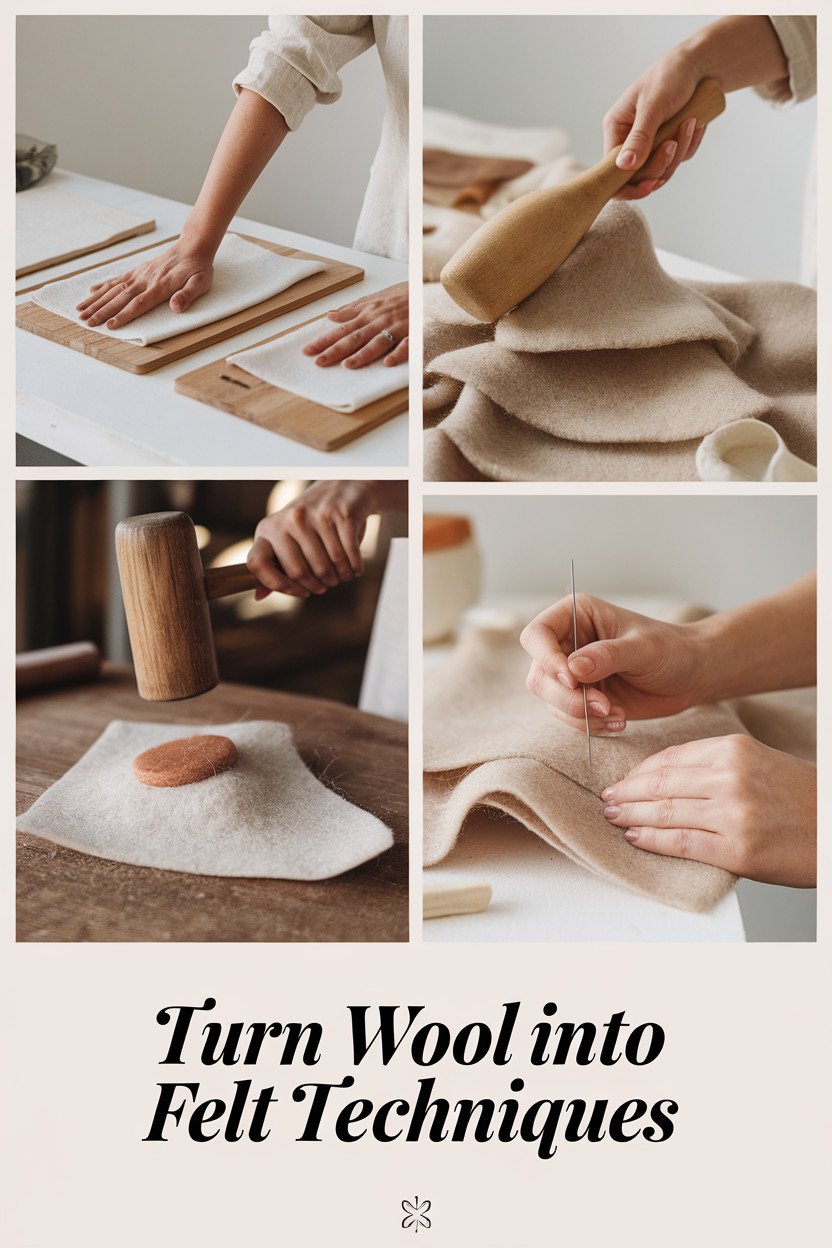Felting involves matting wool fibers together to create a solid piece of fabric that can be molded into shapes, designs, and patterns.
From needle felting to wet felting and beyond, there are many techniques to explore and experiment with.
- Felting involves matting wool fibers to create fabric
- There are many felting techniques to explore, including needle felting and wet felting
- Felting offers endless possibilities for creating unique and stunning projects
- Felting can be enjoyed by both beginners and experienced crafters
- Experimentation and creativity are key to mastering felting techniques
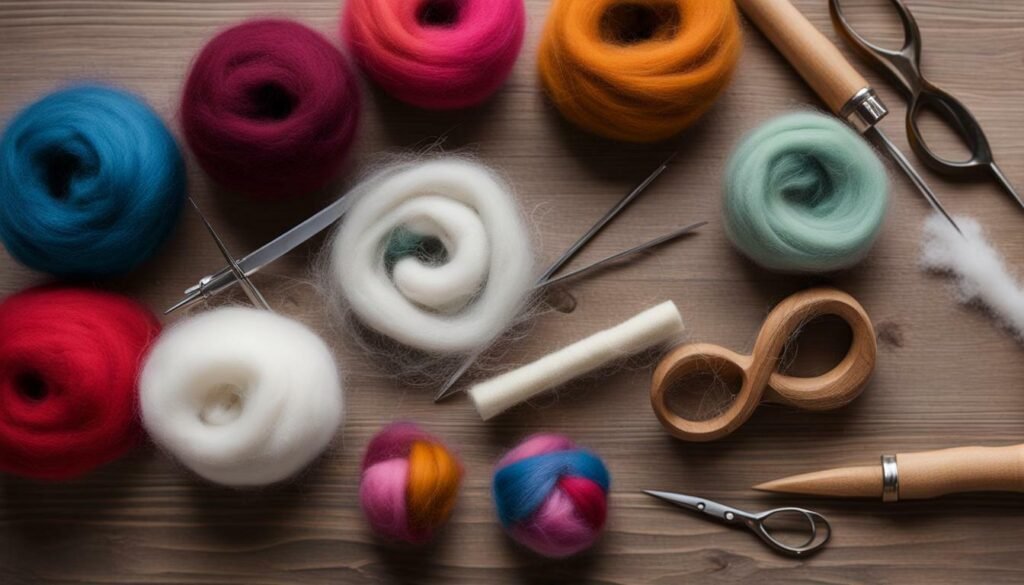
Felting Beginner’s Guide
If you’re new to felting, don’t worry! It’s easy to get started with this fun and rewarding craft. Here are some tips to help you begin your felting journey:
- Start with a simple project, such as a felted ball or coaster, to get the hang of the process.
- Choose a felting method that suits your style and interests. Needle felting is great for detailed designs, while wet felting allows for more organic shapes.
- Invest in high-quality wool roving to ensure the best results. Merino wool is a popular choice for felting projects.
- Get comfortable with felting needles and foam pads, which are essential tools for needle felting. A laundry washboard can be useful for wet felting.
- Take your time and don’t be afraid to experiment. Felting is a forgiving craft, and mistakes can often be corrected or turned into interesting design elements.
Exploring Needle Felting
If you’re looking for a fun and versatile felting technique, needle felting is a great option. This technique involves using a special barbed needle to interlock wool fibers and create intricate designs or sculptures.
- Choose the right needles: Different projects may require different types of needles. Fine needles are used for detailed work, while coarse needles are better for felting larger areas.
- Get the right type of wool: You’ll need wool that is suited for needle felting, such as carded wool or roving. Avoid using yarn, as it won’t hold together as well.
- Invest in felting supplies: In addition to needles and wool, you may want to invest in a foam pad or felting mat to protect your work surface, as well as small scissors and wire cutters to help shape your project.
- Start with simple shapes: It’s best to start with simple shapes like balls or hearts before moving on to more complex designs.
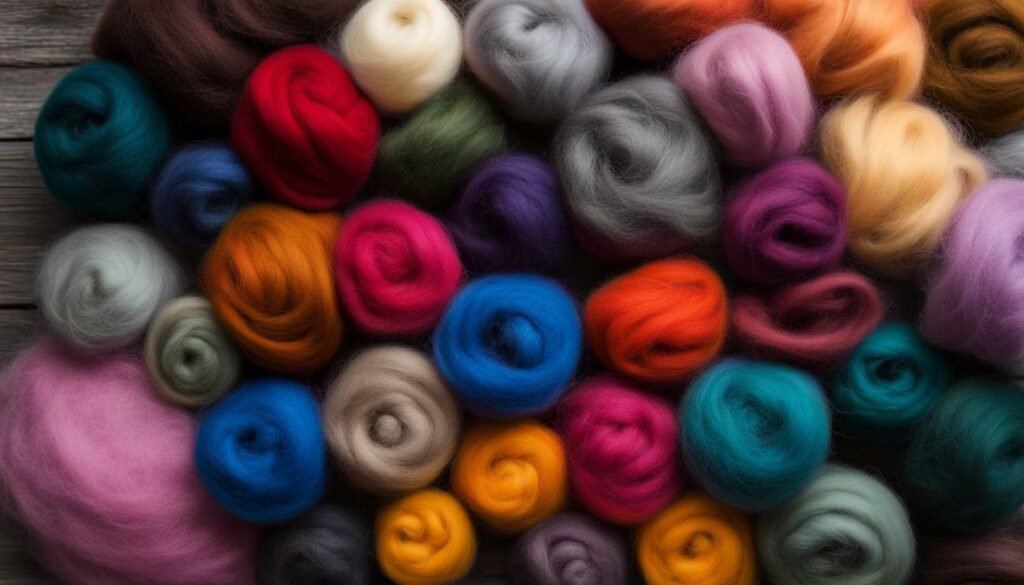
Unleashing your Creativity with Wet Felting
- Choose high-quality felting wool that is suitable for wet felting. Merino wool is a popular choice, but you can also experiment with other types of wool, such as alpaca or silk.
- Prepare your work surface by covering it with bubble wrap or a special felting mat. This will provide the necessary resistance for the fibers to interlock and felt together.
- Layer your wool fibers in different directions to create a strong and stable felted piece. You can also add other fibers, such as silk or cotton, for added texture and visual interest.
- Gently wet your wool fibers with warm, soapy water and use your hands to agitate the fibers. Be careful not to agitate too vigorously, as this can cause the fibers to felt too quickly and unevenly.
- Roll your felted piece in a towel or bamboo mat to remove excess water and further interlock the fibers. Repeat this step several times until your piece has fully felted.

The Art of Nuno Felting
Nuno felting is a delicate technique that combines the softness of fine fabrics with the texture of felt. The result is an elegant and luxurious material with endless possibilities.
Here are some felting tips and tricks to help you succeed with nuno felting:
- Use lightweight fabrics such as silk, wool, or cotton gauze for the base layer.
- Choose wool roving in colors that complement your fabric for the top layer.
- Wet the fabric and wool with warm, soapy water and gently rub the wool into the fabric with your hands.
- For added texture and dimension, consider incorporating other fibers such as silk hankies or locks of wool.
- Experiment with different patterns and designs to create unique and beautiful pieces.
Tips for Success
Nuno felting can take time and patience to master, but the results are well worth it.
- Be gentle when working with the fabric and wool to avoid tearing or damaging the delicate fibers.
- Use a felting mat to protect your work surface and give your hands a break from the constant rubbing.
- Consider using a resist to create an open area in your design, such as a window in a felted wall hanging.
- Take your time and enjoy the process. Nuno felting is a meditative and rewarding craft that can be enjoyed by crafters of all skill levels.
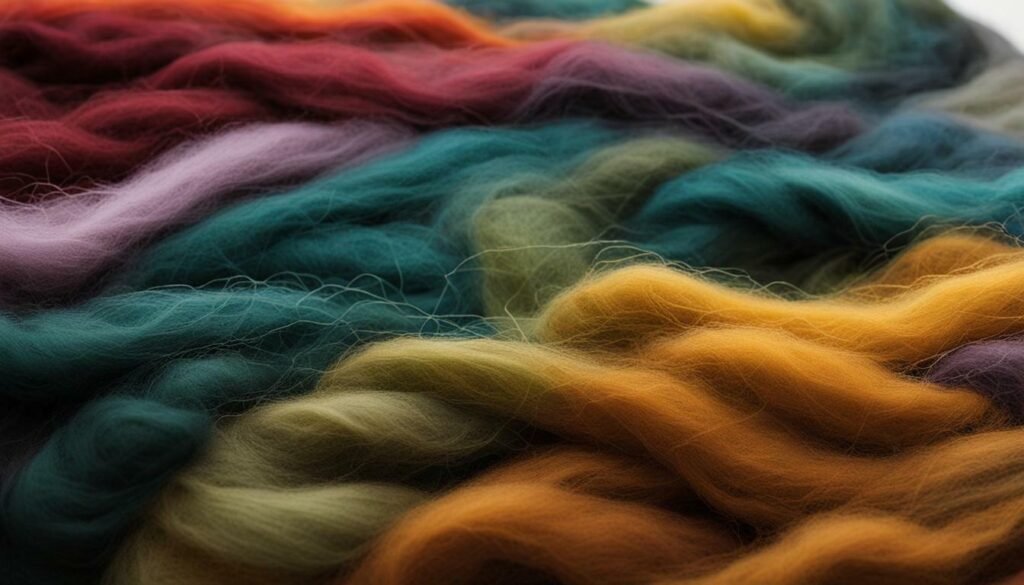
Adding Embellishments to your Felting Projects
Take your felting projects to the next level by adding embellishments. From beads and sequins to embroidery stitches, explore various ways to enhance the visual appeal of your felted creations.
- Consider adding trims, like lace or ribbon, to add a delicate touch to your project.
- Experiment with different types of beads, such as seed beads or glass beads, to add texture and dimension.
- Try incorporating embroidery stitches, like French knots or satin stitch, to add intricate patterns.
- For a more playful design, consider using pompoms or tassels as embellishments.
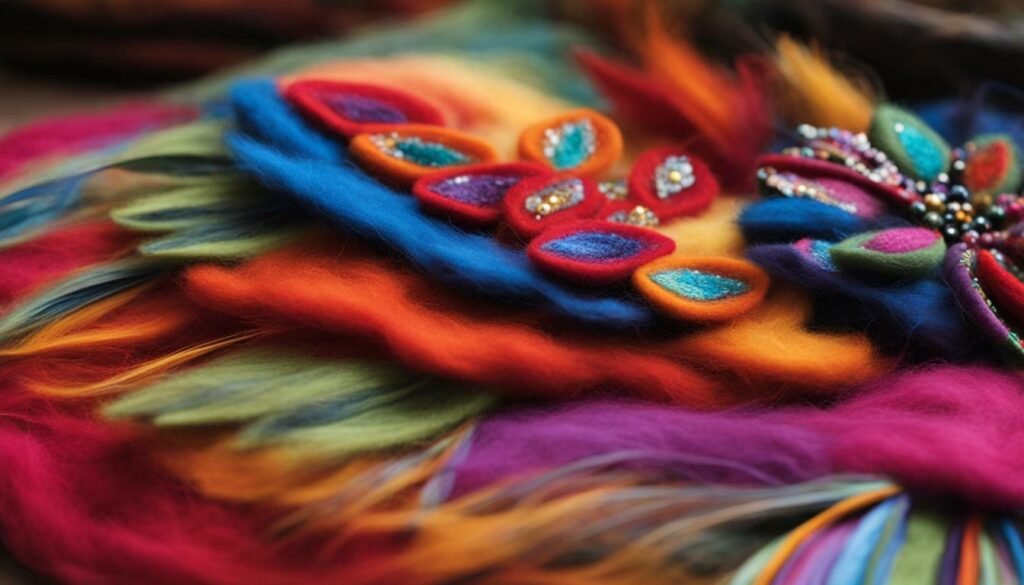
Felting Techniques for Unique Projects
Ready to use your newly acquired felting skills to create unique projects? Here are some felting techniques tailored for specific projects:
- Accessories: Felted accessories like scarves, hats, and mittens make great gifts or additions to your own wardrobe. Experiment with different colors, textures, and embellishments to create one-of-a-kind pieces.
- Home decor: Create cozy home decor items like pillows, blankets, and wall hangings with wet felting techniques. Incorporate colors and designs that match your personal style and existing decor.
- Clothing: Take your fashion game up a notch by felting clothing items like vests, jackets, and skirts. Use nuno felting techniques for a delicate and lightweight look, or explore sculptural felting for more structural pieces.
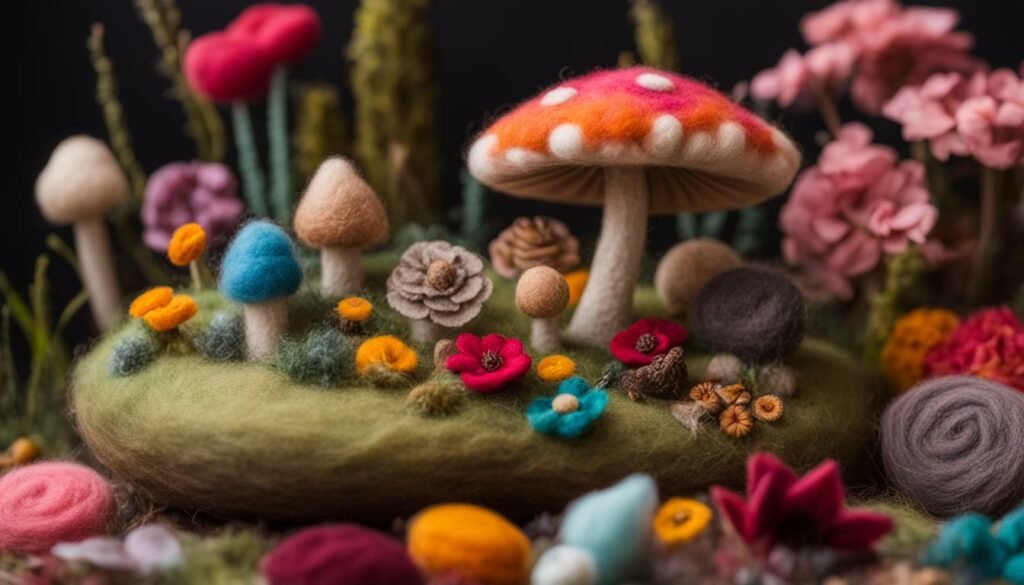
Congratulations! You’ve now mastered the basics of felting and are ready to level up your skills with advanced techniques.
- Seamless felting: Learn how to create seamless felted pieces by carefully blending and felting the wool fibers together.
- Sculptural felting: Experiment with shaping wool fibers into three-dimensional forms, such as animals or plants.
- Intricate patterns: Use techniques such as layering and needle felting to create detailed and intricate designs in your felted projects.
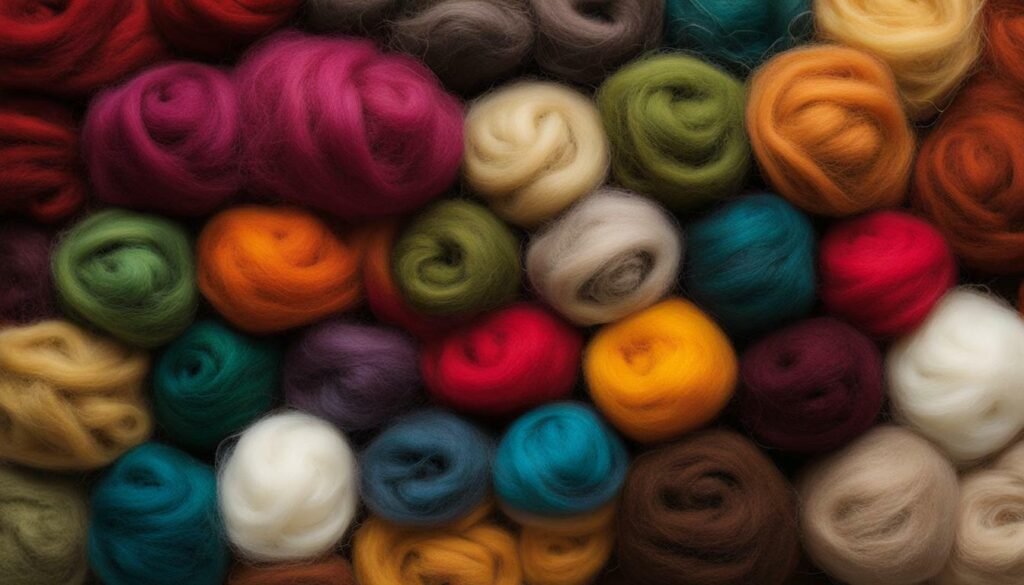
Felting Tips and Tricks
Need a little extra help perfecting your felting projects? Look no further than these useful tips and tricks:
- When needle felting, make sure to stab the needle straight up and down to avoid breaking it
- For wet felting, use hot water and dish soap to help agitate the fibers more easily
- Use a felting needle with a larger gauge for faster felting, and a smaller gauge for more detail work
- To prevent your wool from getting too fuzzy, use a gentle touch when felting

Ready to start your felting journey? You’ll need to build your collection of essential felting supplies first.
- Felting Needles: Choose from a variety of sizes depending on your project needs. Three sizes are recommended: 36, 38, and 40 gauge needles.
- Felting Mat: Protect your work surface and improve needle penetration with a foam felting mat.
- Felting Wool: Choose high-quality wool in a variety of colors and types. Merino wool is a popular choice for its softness and versatility.
- Scissors: A good pair of scissors is essential for trimming and shaping your felted projects.
- Other supplies: Embroidery thread, sequins, beads, and other embellishments can add visual interest to your projects. A spray bottle filled with soapy water and a small bowl for mixing it can also be helpful for wet felting.
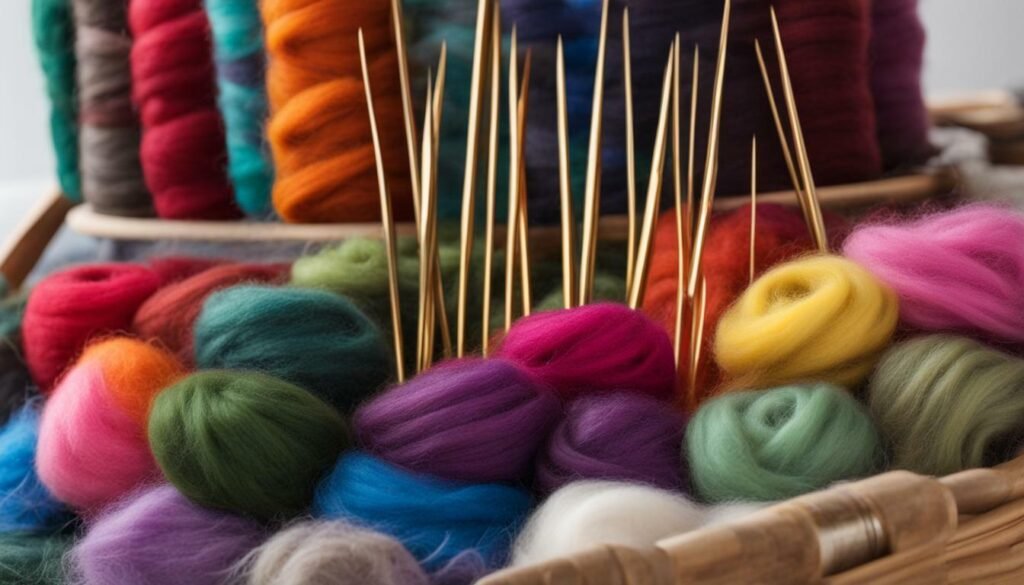
Where can you find these supplies? Craft stores such as Michaels and Joann Fabric and Craft stores offer a wide variety of felting supplies. You can also find them online on websites such as Amazon and Etsy.
Exploring Different Types of Felting Wool
Choosing the right type of wool is crucial for achieving the desired effect in your felting projects.
- Merino wool: known for its softness and elasticity, merino wool is a popular choice for both needle felting and wet felting projects.
- Alpaca wool: prized for its luxurious feel and natural sheen, alpaca wool is ideal for creating textured and fluffy felted designs.
- Corriedale wool: a versatile wool that is easy to work with, corriedale wool is a great choice for both beginners and experienced crafters.
You can also experiment with other types of wool, such as Romney, Bluefaced Leicester, and Icelandic wool, to create unique textures and effects.
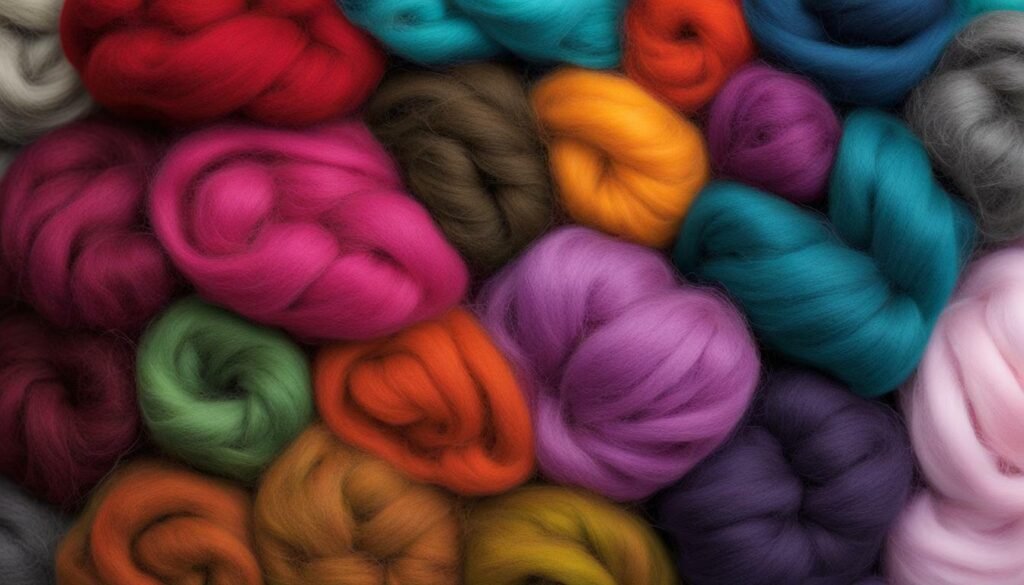
Felting Techniques for Texture and Dimension
If you want to take your felted creations to the next level, consider incorporating texture and dimension into your designs. Here are some felting techniques to achieve just that:
- Create three-dimensional shapes by felting around a wire or pipe cleaner frame.
- Add different fiber lengths to create texture, such as using curly wool for hair or a fluffy wool for a cloud.
- Experiment with different felting needle sizes to create varying textures.
- Layer different colors of wool to create depth and dimension.
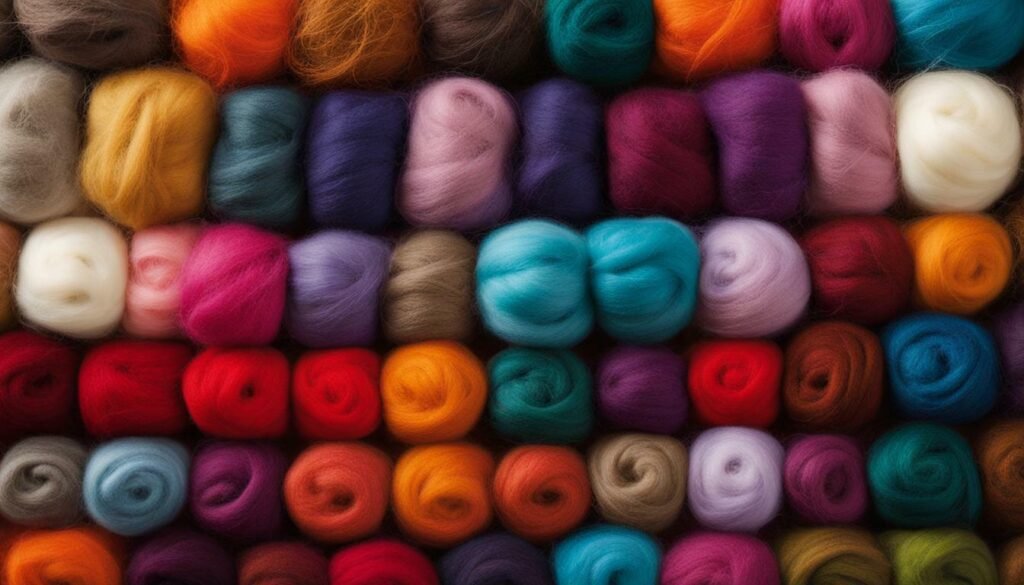
Color can make or break a felting project. It is essential to use the right colors to achieve the desired effect.
- Blend different colors of felting wool to create unique shades and hues.
- Use pre-dyed wool to add a pop of color to your projects.
- Experiment with natural dyes to create a more organic look.
- Try adding small amounts of contrasting colors to create interest and depth.

Felting Techniques for Personalization
Make your felting projects truly unique by incorporating personal touches.
- Needle felting initials or designs onto your felted creations is a great way to personalize them.
- Use fabric scraps to add color and texture to your felting projects. Try felting scraps of silk, cotton, or even lace into your wool fibers for a beautiful effect.
- Create your own custom patterns by drawing or tracing designs onto a piece of paper, then using them as a template for your felting.

Now that you’ve explored a wide range of felting techniques and gained valuable tips and tricks, it’s time to put your knowledge into practice.
- Start with simple projects and gradually work your way up to more complex ones.
- Experiment with different types of felting and find the techniques that best suit your personal style and creative vision.
- Don’t be afraid to make mistakes – they often lead to new discoveries and unexpected outcomes.
- Stay organized and keep your felting supplies neatly stored to maximize your workspace and minimize stress during your creative process.
- Join a community of fellow felting enthusiasts online or in person to share ideas, ask questions, and gain inspiration.
FAQs
What is nuno felting?
Nuno felting is a technique that combines felted wool with fine fabrics, such as silk or chiffon. The wool fibers migrate through the fabric and bond together during the felting process, creating a delicate and textured design.
How can I add embellishments to my felting projects?
There are many ways to embellish your felting projects, including adding beads, sequins, embroidery stitches, or even fabric scraps. These embellishments can enhance the visual appeal and add texture to your felted creations.
What types of projects can I create with felting?
The possibilities are endless! With felting techniques, you can create accessories like hats and scarves, home decor items like pillows and wall hangings, and even clothing. Let your imagination guide you.
Are there advanced felting techniques?
Yes! Once you’ve mastered the basics, you can explore advanced techniques such as seamless felting, sculptural felting, and creating intricate patterns.
What are some tips and tricks for successful felting?
Felting can sometimes be tricky, but with these tips and tricks, you’ll have more successful projects. Some tips include using hot water and soap for wet felting, starting with simple designs for needle felting, and practicing patience and perseverance.
What supplies do I need for felting?
Basic felting supplies include felting needles, foam pads or brushes, wool roving or batts, hot water, and soap for wet felting. Additional supplies may include felting tools, embellishments, and various types of wool for different techniques.
What types of felting wool should I use?
Merino wool is a popular choice for its softness and felting properties. Other options include alpaca wool, Corriedale wool, and specialty fibers like silk or bamboo.
How can I add texture and dimension to my felting projects?
You can create three-dimensional shapes, incorporate different fiber lengths, and experiment with different felting methods like sculptural felting or nuno felting.
How can I achieve vibrant colors in my felting projects?
Achieving vibrant colors in felting involves dyeing wool, blending different colors of fiber, and using pre-dyed wool. You can experiment with different dyeing techniques and color combinations to create stunning effects in your felted projects.
Can I personalize my felting projects?
Absolutely! Felting projects can be personalized by incorporating initials or designs through needle felting, using fabric scraps for added details, or creating custom patterns. Adding that special touch makes your felted creations truly unique.
How do I get started on my felting journey?
Now that you’ve learned about a variety of felting techniques, it’s time to start your own felting journey. Happy felting!
